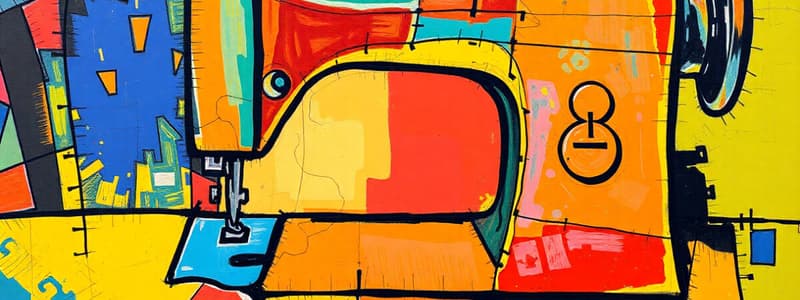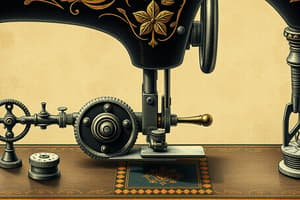Podcast
Questions and Answers
How does proper corrective maintenance contribute to the longevity of sewing machines?
How does proper corrective maintenance contribute to the longevity of sewing machines?
It helps prevent wear and tear through timely repairs and adjustments, ensuring a longer operational life.
What role does corrective maintenance play in the performance consistency of sewing machines?
What role does corrective maintenance play in the performance consistency of sewing machines?
It maintains the machine's performance at a consistent and reliable level, producing uniform stitches.
Why is regular maintenance important in minimizing product defects?
Why is regular maintenance important in minimizing product defects?
Regular maintenance reduces the likelihood of defects in stitched products, ensuring high quality.
How can well-maintained sewing machines contribute to safety compliance?
How can well-maintained sewing machines contribute to safety compliance?
In what ways does customer satisfaction relate to the maintenance of sewing machines?
In what ways does customer satisfaction relate to the maintenance of sewing machines?
What impact does preventive maintenance have on equipment longevity?
What impact does preventive maintenance have on equipment longevity?
How does preventive maintenance help in reducing downtime?
How does preventive maintenance help in reducing downtime?
What are the cost benefits of investing in preventive maintenance for sewing machines?
What are the cost benefits of investing in preventive maintenance for sewing machines?
What can cause uneven stitching in sewing?
What can cause uneven stitching in sewing?
Explain the issue of skipped stitches and its impact on the final product.
Explain the issue of skipped stitches and its impact on the final product.
How can tension issues lead to puckering in fabric during sewing?
How can tension issues lead to puckering in fabric during sewing?
Identify and describe one defect related to bobbins.
Identify and describe one defect related to bobbins.
Why is corrective maintenance important for sewing machines?
Why is corrective maintenance important for sewing machines?
What are the implications of mismatched thread color in a sewing project?
What are the implications of mismatched thread color in a sewing project?
Describe one effect of seam slippage on a garment's construction.
Describe one effect of seam slippage on a garment's construction.
What outcomes result from inconsistencies in seam allowance?
What outcomes result from inconsistencies in seam allowance?
How does regular maintenance of sewing machines contribute to product quality?
How does regular maintenance of sewing machines contribute to product quality?
What role does preventive maintenance play in improving the efficiency of sewing machines?
What role does preventive maintenance play in improving the efficiency of sewing machines?
In what way does regular inspection during preventive maintenance enhance safety?
In what way does regular inspection during preventive maintenance enhance safety?
Why is adherence to safety standards essential in industrial sewing settings?
Why is adherence to safety standards essential in industrial sewing settings?
How can preventive maintenance benefit operators in terms of skill development?
How can preventive maintenance benefit operators in terms of skill development?
What impact does regular maintenance have on the energy efficiency of sewing machines?
What impact does regular maintenance have on the energy efficiency of sewing machines?
Explain how preventive maintenance can affect the resale value of a sewing machine.
Explain how preventive maintenance can affect the resale value of a sewing machine.
What benefits does Industry 4.0 bring to the garment industry through automation and robotics?
What benefits does Industry 4.0 bring to the garment industry through automation and robotics?
How does data analytics aid the garment industry in managing production efficiently?
How does data analytics aid the garment industry in managing production efficiently?
What advantages does predictive maintenance provide to garment manufacturing machinery?
What advantages does predictive maintenance provide to garment manufacturing machinery?
In what ways does Industry 4.0 enable customization in garment manufacturing?
In what ways does Industry 4.0 enable customization in garment manufacturing?
Explain how digital technologies enhance supply chain visibility in the garment industry.
Explain how digital technologies enhance supply chain visibility in the garment industry.
What role does 3D printing play in the garment industry’s design and development process?
What role does 3D printing play in the garment industry’s design and development process?
How does Industry 4.0 support e-commerce integration in garment manufacturing?
How does Industry 4.0 support e-commerce integration in garment manufacturing?
Describe the impact of AR and VR technologies on the online shopping experience in the garment industry.
Describe the impact of AR and VR technologies on the online shopping experience in the garment industry.
What are the implications of Industry 4.0 on skill requirements for the workforce in garment manufacturing?
What are the implications of Industry 4.0 on skill requirements for the workforce in garment manufacturing?
Flashcards
Uneven Stitching
Uneven Stitching
Stitching lines that aren't consistent in length or spacing.
Skipped Stitches
Skipped Stitches
Sewing machine misses stitches, creating gaps in the fabric.
Puckering
Puckering
Fabric wrinkles or gathers around stitches; often due to tension issues.
Thread Breakage
Thread Breakage
Signup and view all the flashcards
Corrective Maintenance
Corrective Maintenance
Signup and view all the flashcards
Quality Control
Quality Control
Signup and view all the flashcards
Reduced Downtime
Reduced Downtime
Signup and view all the flashcards
Cost Savings
Cost Savings
Signup and view all the flashcards
Machine Lifespan
Machine Lifespan
Signup and view all the flashcards
Consistent Performance
Consistent Performance
Signup and view all the flashcards
Product Quality
Product Quality
Signup and view all the flashcards
Safety
Safety
Signup and view all the flashcards
Customer Satisfaction
Customer Satisfaction
Signup and view all the flashcards
Efficient Workflow
Efficient Workflow
Signup and view all the flashcards
Operator Morale
Operator Morale
Signup and view all the flashcards
Consistent Product Quality
Consistent Product Quality
Signup and view all the flashcards
Preventive Maintenance
Preventive Maintenance
Signup and view all the flashcards
Improved Efficiency
Improved Efficiency
Signup and view all the flashcards
Safety Assurance
Safety Assurance
Signup and view all the flashcards
Adherence to Standards
Adherence to Standards
Signup and view all the flashcards
Operator Training
Operator Training
Signup and view all the flashcards
Energy Efficiency
Energy Efficiency
Signup and view all the flashcards
Preservation of Resale Value
Preservation of Resale Value
Signup and view all the flashcards
Automation in Garment Industry
Automation in Garment Industry
Signup and view all the flashcards
Demand Forecasting
Demand Forecasting
Signup and view all the flashcards
Customization in Garment Manufacturing
Customization in Garment Manufacturing
Signup and view all the flashcards
Supply Chain Visibility
Supply Chain Visibility
Signup and view all the flashcards
3D Printing in Prototyping
3D Printing in Prototyping
Signup and view all the flashcards
E-Commerce Integration in Garment Industry
E-Commerce Integration in Garment Industry
Signup and view all the flashcards
AR/VR for Virtual Fitting Rooms
AR/VR for Virtual Fitting Rooms
Signup and view all the flashcards
Sustainability in Garment Industry
Sustainability in Garment Industry
Signup and view all the flashcards
Study Notes
Industrial Garment Machinery - Fashion Technology III Semester
- Course covers industrial garment machinery
- Focuses on sewing defects and maintenance.
Different Types of Sewing Defects
- Uneven Stitching: Stitching lines inconsistent in length or spacing.
- Skipped Stitches: Sewing machine misses stitches, creating gaps.
- Puckering: Fabric gathers or wrinkles around stitches, often due to tension issues.
- Thread Breakage: Thread snaps during sewing, leading to incomplete seams.
- Seam Slippage: Fabric layers shift or pull apart, compromising seam integrity.
- Incorrect Tension: Uneven tightness of stitches, causing loops or puckering.
- Bobbin Issues: Problems with bobbin thread (tangling, uneven winding), leading to defects.
- Fabric Damage: Fabric can get snagged, torn, or stretched.
- Misaligned Patterns: Patterns or designs don't match up correctly.
- Overlapping Seams: Sewing lines cross or overlap unintentionally.
- Inconsistent Seam Allowance: Variations in seam allowance width.
- Notches and Clipping Mistakes: Errors in cutting notches or clips, affecting fit and appearance.
- Mismatched Thread Color: Using the wrong thread color, creating a noticeable defect.
- Zigzagging Seams: Straight seams unintentionally zigzag, creating an irregular appearance.
Need for Corrective Maintenance
- Quality Control: Corrective maintenance addresses defects promptly, ensuring product quality meets standards.
- Reduced Downtime: Regular corrective maintenance prevents prolonged machine downtime, crucial for production efficiency.
- Cost Savings: Addressing small issues early prevents escalating into major problems, reducing repair costs.
- Extended Machine Life: Timely repairs and adjustments extend the sewing machine's lifespan.
- Consistent Performance: Corrective maintenance maintains consistent machine performance, producing uniform stitches.
Need for Preventive Maintenance
- Equipment Longevity: Regular inspections, cleaning, and lubrication prevent wear and tear, extending machine lifespan.
- Reduced Downtime: Addressing potential issues before they escalate prevents unexpected breakdowns.
- Cost Savings: Preventive maintenance is more cost-effective than major repairs or replacements.
- Consistent Product Quality: Maintaining optimal operation ensures consistent high-quality stitches, meeting product standards.
- Improved Efficiency: Preventive maintenance enables smooth and precise stitching, improving overall efficiency.
Minimized Product Defects, Safety Compliance, Customer Satisfaction, Efficient Workflow, Operator Morale
- Minimized Product Defects: Regular maintenance reduces the likelihood of product defects.
- Safety Compliance: Well-maintained machines pose fewer safety hazards.
- Customer Satisfaction: Well-maintained machines produce high-quality products, leading to customer satisfaction.
- Efficient Workflow: Minimizing machine malfunctions maintains a smooth workflow.
- Operator Morale: Well-maintained machines create a more enjoyable experience for operators, improving morale and productivity.
Safety Assurance, Adherence to Standards, Operator Training, Energy Efficiency, Preservation of Resale Value
- Safety Assurance: Regular inspections identify and address safety concerns.
- Adherence to Standards: Maintenance ensures machines meet quality and safety standards.
- Operator Training: Operator training on best practices enhances efficiency.
- Energy Efficiency: Well-maintained machines operate more energy-efficiently.
- Preservation of Resale Value: Well-documented maintenance history enhances resale value.
Effects of Industry 4.0 in Garment Industry
- Automation and Robotics: Implementation of robotics streamlines production.
- Smart Factories: Garment factories utilize IoT devices for real-time monitoring.
- Data Analytics and Predictive Maintenance: Data analytics optimize operations and prevent breakdowns.
- Customization and Personalization: Industry 4.0 enables greater customization.
- Supply Chain Visibility: Digital technologies provide enhanced visibility across the supply chain.
- 3D Printing and Digital Prototyping: Rapid prototyping and customized components are enabled.
- E-commerce Integration: Seamless integration with online platforms improves efficiency.
- Augmented Reality (AR) and Virtual Reality (VR): Customers can visualize garments before purchasing.
- Sustainability and Traceability: Technology supports sustainability initiatives and material tracking.
- Skill Requirements and Workforce Changes: Adapting to new technologies requires workforce skills development.
Studying That Suits You
Use AI to generate personalized quizzes and flashcards to suit your learning preferences.
Related Documents
Description
This quiz focuses on the various types of sewing defects encountered in industrial garment machinery. Explore key concepts related to maintenance and the impact of defects like uneven stitching, skipped stitches, and incorrect tension on garment quality.




